Loquat is also known as Japanese plum, Chinese plum, Japanese medlar, pipa, and nespolo. This delicious fruit has a juicy, sweet flavor. It tastes like apricots, plums, and cherries added together and divided by two.
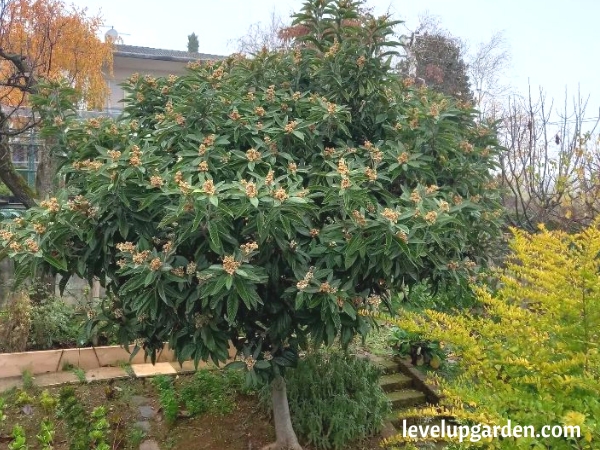
The Loquat tree is a rare and very ornamental large shrub or small tree that flowers in the fall and bears fruit in early spring when there is no other fresh fruit in the garden. The flowers are beautiful, and each fall the tree is noted for its rich, sweet fragrance in the garden.
As the surrounding trees go into rest for the winter, the Loquat tree is a spectacular sight as it blooms en masse. The fruit is delicious and can be used for cooking in a variety of ways, offering great variety.
The Loquat tree is very easy to grow, and residents in zones 7 to 10 will have no problem getting it to grace their yards beautifully. This tree grows in full sun or partial shade and can be left unpruned or pruned as hard as needed. It will grow in any soil and requires no special care. In cold climates, it can be planted in large containers to protect it from frost.
Grow Loquat fruit in your backyard, the Loquat tree is an attractive evergreen tree with orange fruit. They bloom in the fall and early winter, and the fruit usually ripens in early spring or early summer. The Loquat tree is very easy to grow and requires no maintenance once planted.
Native to China, it is not as well known as other fruit trees, but it should be. The Loquat tree is grown not only for its beauty, but also for its delicious fruit. Its shape, glossy foliage, and aromatic flowers are always the center of attention.
I. Plant Profile – An Overview of the plant
| Common name | Loquat Japanese Plum, Loquat, Japanese Loquat, Japanese Medlar, Japanese plum, Nispero |
| Botanical Name | Eriobotrya japonica |
| Hardiness Zone | 7 – 10 |
| Mature Height | 10-22 ft. |
| Mature Width | 10-18 ft. |
| Sunlight | Full sun to part shade |
| Growth Rate | Moderate |
| Bloom Time | November to December |
| Bloom Description | White |
| Water | Medium |
| Maintenance | Low |
| Flower | Showy, Fragrant |
| Leaf | Evergreen |
II. Appearance
The Loquat tree is an unusual small tree or large shrub around 15 feet tall with a dense canopy of large, attractive leaves. Bold in appearance, its large leaves give a slightly tropical look to the garden and blend well with many other types of plants, from deciduous trees to palms.

The white flowers bloom in the fall and have a sweet fragrance. This is an easy, low-maintenance tree that produces 1-2 cm yellow berries every spring that make delicious jams and preserves. Fruits begin to ripen in late winter and spring, so they can be harvested over a long period of time.
They need to ripen on the tree until they are soft. Each fruit contains a few large black seeds, which should not be eaten. The pale yellow flesh is fragrant and has a unique flavor that is a blend of peach, citrus, and mango. They can be eaten raw, added to fruit salads, soaked in syrup, lined into pies, or made into sweet or spicy jams and delicious chutneys.
III. Growing and Care Conditions
Tropical evergreen shrub or tree with alternate, simple, leathery, veined, toothed leaves. The upper part of the leaf is smooth and the lower part is downy with short hairs. It is sensitive to cold, thus, it does not usually fruit in North Carolina. If temperatures fall below 28 degrees Fahrenheit, the flowers and fruit will likely not survive. Trees can tolerate up to 10 degrees Fahrenheit.
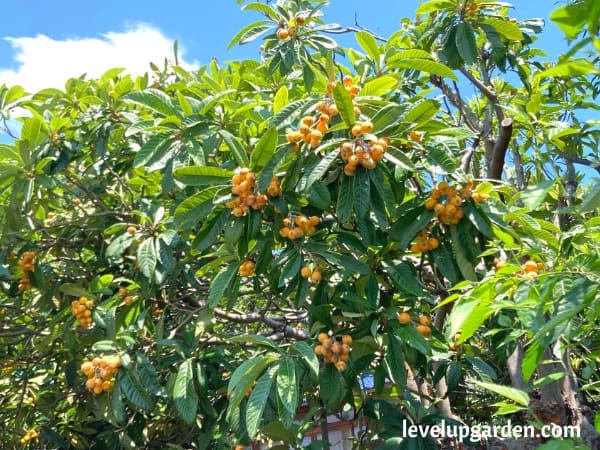
The plant attracts hummingbirds and bees, making it a good accent and screening plant. It is also resistant to deer damage and has a moderate salt tolerance. Native to China and Japan, the texture of the leaves is interesting in winter.
Planting
First, choose a location that gets plenty of sun (6-8 hours per day) and is large enough to accommodate the tree. Unless you regularly prune the tree to adjust its size, keep it at least 25 feet away from structures, sidewalks, and driveways. Also, always make sure the soil is well-drained.
When ready to plant, drill a hole three times as wide and three times as deep as the rootball. Place the tree in the hole and backfill it with the soil you removed, making sure it is straight. Finally, water the tree to settle the roots and place 2 to 3 inches of mulch around the perimeter.
If planting in a container, simply choose a pot about twice the size of the shipping container, use a well-balanced culture, place the tree, backfill, and water. Then plant the Loquat indoors near a sunny window or on a balcony in a sunny spot.
Light
Loquat grows best in areas that receive at least 6 to 8 hours of direct sunlight per day, but can also tolerate some shade. Look for a sunny, well-drained soil in full sun to semi-shade. Early morning sun and afternoon sunset are ideal.
Watering
Loquat will benefit from watering every other day for the first week and then once or twice a week for the next two months. During periods of drought, watering should be done at least once a week. During the rainy season, watering is not necessary at all. For indoor Loquats, simply check the soil with your index finger and water if the soil is dry about 3 cm below the surface.
Fertilizer
Biwa should be fertilized three times a year with a lawn fertilizer. Use 1 cup of fertilizer three times during the growing season; increase to 2 cups in the second and third years, spreading the fertilizer on the ground before watering.

If you prefer to use an organic fertilizer, use 2 to 3 pounds of old manure, 2 tablespoons of greensand (a type of greenish sandstone), or 1 tablespoon of rock phosphate.
Soil Requirements
Loquat ‘Japanese Plum’ prefers well-drained, moist, loamy soil in full sun, but can tolerate partial shade. It is easy to grow and tolerates alkaline soils and drought.
Temperature
Loquat is cold tolerant and can withstand temperatures up to 8-10°C. However, Loquat is sensitive to cold and may not fruit in cold locations. If temperatures fall below 28 degrees F, there is a good chance that neither flowers nor fruit will remain. The tree can tolerate up to 10 degrees Fahrenheit.
Pruning
Pruning Loquat trees not only improves their appearance, but also improves the harvest. If you remove dead growth from the Loquat the previous fall, it will produce more ears of flowers in the spring. Pruning will allow more light to reach the lower branches, making it easier to produce fruit.
Improved air circulation will also improve fruit production and the overall health of the tree. Dead or diseased branches should be removed at any time, but severe pruning should continue throughout the fall and winter. Keeping the tree from growing too tall will also help at harvest time.
Pests and Diseases
Ladybugs and natural neem oil are the strongest weapons against Loquat tree pests, but in serious cases you may have to resort to insecticides. However, be careful not to harm pollinators or beneficial insects. Aphids, black flies, codling moths, and fruit flies are pests to watch out for. Cod flies can be easily eliminated by keeping the area under and around the tree free of fallen fruit and debris.
Biwa trees can suffer from a serious bacterial disease called burn blight. This disease occurs in humid, very wet conditions. First, remove infected branches and parts of the tree and burn them. For mild infections, copper-based fungicides can be used, but there is no chemical treatment for burns.
The Loquat fruit is an attractive attractant for many birds and deer. It may be necessary to cover Loquat trees with bird netting and fence them off to keep deer and other varmints from wandering in.
Pollination
Some varieties of Loquat are self-pollinating. Some varieties require another tree for pollination. If you have only one tree in your garden, choose a variety that is self-pollinating. If you have more than one Loquat tree, you will have a better chance of pollinating other flowers and will get a better harvest. Biwa trees do not like the cold, the tree can tolerate freezing temperatures, but the flowers and fruit cannot.
IV. Uses
It can be planted in any sunny location. This evergreen tree can be enjoyed all year round, so the front yard is the perfect place for this distinctive fruit tree. This tropical fruit tree is a great ornamental tree for large mixed plantings and unique gardens. The Loquat resembles an apricot and has a delicious flavor somewhere between peach and mango.
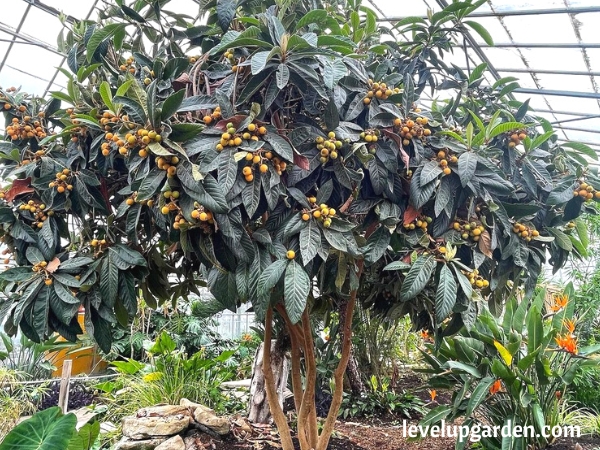
The Loquat is a highly medicinal plant with a variety of organs and has been used historically as a folk medicine for thousands of years. Biwa extract has been used in Chinese folk medicine to treat coughs, chronic bronchitis (CB), inflammation, diabetes, and cancer.
The efficacy of Loquat used in traditional Chinese medicine is supported by current scientific evidence on the pharmacologically active compounds in plant extracts and their structure-activity relationships. Biwa leaves and flowers are rich in phenols and triterpenes; fruits are rich in sugars, organic acids, carotenoids, flavonoids, phenolic acids, and vitamins; and kernels are rich in proteins, starch, tannins, and minerals.
V. Why should you buy this plant
Thanks to Loquat, turning your garden or backyard into a tropical retreat has never been easier. Plant Loquat on its own or in a clump with palm trees to create a tropical paradise in your home. The Loquat also grows to a manageable height when pruned, making it a good size for a variety of planting options.

The leaves are glossy and thick with saw-toothed edges, and the delicate white flowers have an island-like appearance and a fresh fragrance. Its juicy orange pulp has a delicious tropical flavor, like sweet and tangy plums and kumquats combined.
Loquat is classified as a subtropical fruit tree and is a bit more hardy than tropical fruit trees. This is great news for those living in plant hardiness zones 8 to 10 in the United States. The Loquat fruit is an exotic choice for gardeners looking to grow “outside the box” and enjoy this delicious fruit. The Loquat fruit is small, about 15 cm long, but has a sweet, juicy flavor that is a cross between an apricot and a plum.
The Loquat tree is closely related to trees such as apples, pears, peaches, and nectarines. However, unlike these trees, which flower in the spring, the Loquat tree, an evergreen tree, blooms in the fall and winter and rewards us with a harvest at the end of winter.
The Loquat tree can bear fruit even if there is no nearby tree for hybridization. However, it is certain that crossbreeding will improve fruit production. Therefore, it is recommended to plant two or more Loquat trees.
VI. FAQs
What does a Loquat ‘Japanese Plum’ taste like?
The Loquat is shaped like a Christmas tree, with large, fuzzy leaves that are green on the front and silver on the back. The fruit tastes like a combination of peach and apricot. In addition to being eaten raw, they are often made into jelly or wine.
Can Loquats be eaten?
Like other fruits, Loquats can be eaten raw, and the skin is usually eaten as well. However, like apricots, it has a seed in the center, so care must be taken. They can also be used to make pies, jams, and other dishes, just like apples and peaches.
How big do plum trees grow?
Plum varieties suitable for USDA cold hardiness zones 8 through 10 typically reach 10 to 22 feet in height and are somewhat larger in spread. They produce white flowers and delicious fruit in the spring, so you don’t have to wait long.
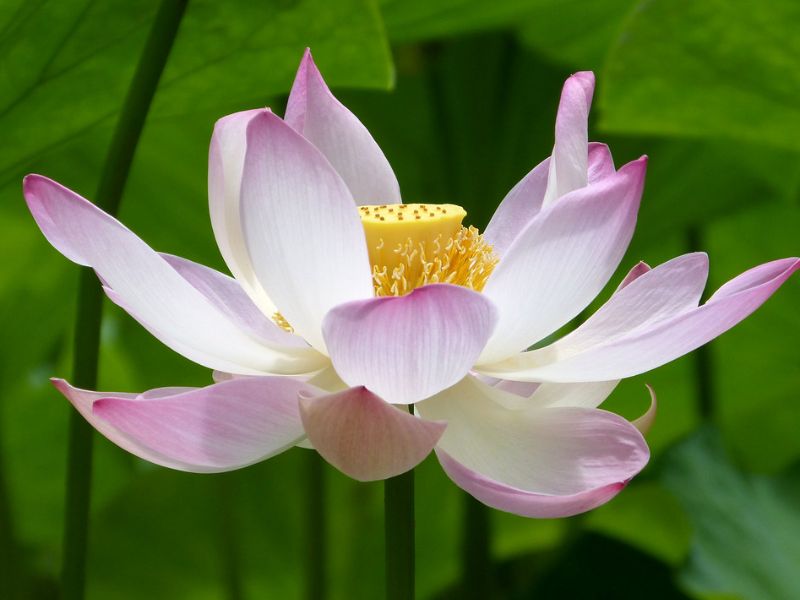
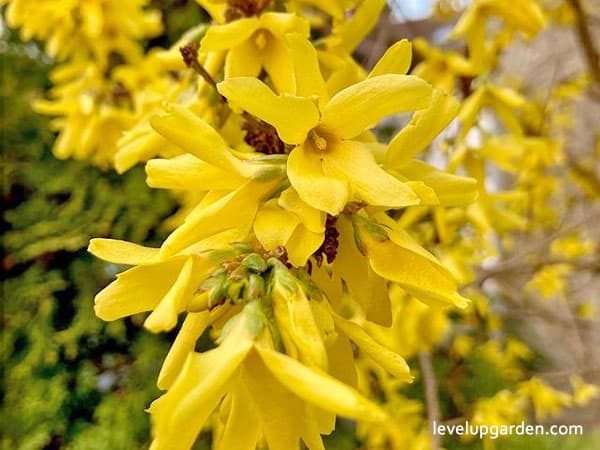






151 responses to “Loquat ‘Japanese Plum’ Tree (Eriobotrya japonica)”